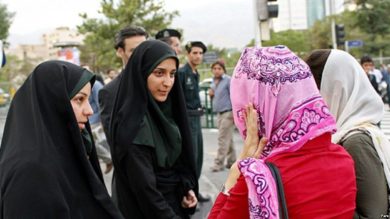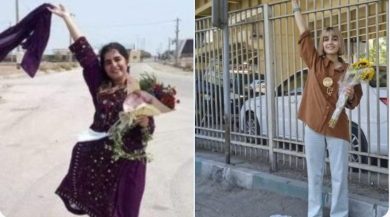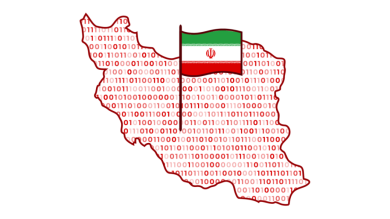The struggle for women’s rights in Iran is not only waged in the streets but also within the dark walls of prisons, where political prisoners—especially women—endure unimaginable suffering. Iranian women, at the forefront of the country’s freedom movement, are often the primary targets of the Islamic Revolutionary Guard Corps (IRGC), which uses incarceration, torture, and psychological abuse to silence dissent.
The IRGC, designated by the United States as a Foreign Terrorist Organization (FTO), serves as the regime’s most powerful apparatus for suppressing opposition. It controls notorious prisons like Evin and Qarchak, where many women activists, journalists, and human rights defenders are held under inhumane conditions. Despite the harrowing experiences, these women continue to resist, becoming symbols of courage for a nation yearning for freedom.
This opinion piece sheds light on:
• The role of the IRGC in imprisoning and abusing women.
• Conditions inside Iranian prisons and the tactics of repression used by the IRGC.
• The stories of brave women who have faced imprisonment.
• The importance of global solidarity in supporting these political prisoners.
1. The IRGC’s Role in Imprisoning Iranian Women
A. The IRGC: Iran’s Enforcer of Oppression
The IRGC is not just a military entity; it is the guardian of the regime’s authoritarian rule. With vast influence over Iran’s political, economic, and social systems, the IRGC:
• Arrests women activists, journalists, and protesters who challenge the regime’s laws, especially those related to gender norms.
• Oversees intelligence operations that track digital activities, leading to arrests for online activism.
• Controls interrogation centers and prisons, where torture and abuse are used to break the spirit of detainees.
B. The Criminalization of Dissent
Women are imprisoned for acts that should never be criminalized, such as:
• Removing the hijab in public.
• Participating in peaceful protests.
• Writing articles criticizing government policies.
• Advocating for human rights and gender equality.
Under IRGC supervision, these actions are labeled as “propaganda against the state”, “acting against national security”, or “corruption on Earth”—charges that carry harsh sentences, including death.
2. Life Inside Iran’s Prisons: The Reality for Women
A. Evin Prison: The Regime’s Torture Chamber
Evin Prison, located in Tehran, is infamous for housing political prisoners, many of whom are women. Under IRGC control, Evin has become synonymous with:
• Torture and sexual violence during interrogations.
• Solitary confinement in small, windowless cells for months at a time.
• Forced confessions extracted under duress, later aired on state television to discredit activists.
• Psychological abuse, including threats against family members.
The IRGC’s goal in Evin is clear: to break the spirit of those who dare to oppose the regime.
B. Qarchak Prison: Hell for Women
Qarchak Prison, located in Varamin, is another notorious detention center for women. It has been described as:
• Overcrowded and unsanitary, with limited access to medical care.
• A place where violent criminals are deliberately mixed with political prisoners to endanger their lives.
• A center for systematic abuse, including denial of legal representation, beatings, and sexual harassment by prison guards.
Conditions in Qarchak have been labeled inhumane by international human rights organizations, yet the IRGC continues to use it as a tool of repression.
C. Tactics of Fear and Control
The IRGC employs various tactics inside prisons to maintain control:
• Denial of family visits, especially for mothers, as a form of psychological torture.
• Physical torture, including whippings, electrocution, and rape.
• Forced medical procedures, such as virginity tests, to humiliate and break women.
• Sleep deprivation and constant interrogation designed to coerce false confessions.
These brutal practices are part of the IRGC’s broader strategy to deter women from participating in Iran’s growing resistance movements.
3. Voices of Courage: Women Who Faced the IRGC’s Prisons
A. Narges Mohammadi: A Voice from Behind Bars
Narges Mohammadi, a human rights defender and Nobel Peace Prize laureate, has spent years in IRGC-run prisons for her activism. She has:
• Spoken out against the death penalty and gender-based discrimination.
• Suffered repeated arrests, torture, and health issues due to inhumane prison conditions.
• Continued to write and campaign from prison, exposing the IRGC’s abuses to the world.
Her courage shows that imprisonment cannot silence the demand for justice.
B. Nasrin Sotoudeh: The Human Rights Lawyer
Nasrin Sotoudeh, an internationally renowned human rights lawyer, has been repeatedly arrested for:
• Defending women prosecuted for removing their hijabs.
• Advocating for political prisoners and minority rights.
• Refusing to wear a hijab during court appearances as an act of civil disobedience.
In 2019, she was sentenced to 38 years in prison and 148 lashes—a clear message from the regime about the cost of defending human rights in Iran.
C. Atena Daemi: Activism from Confinement
Atena Daemi, a children’s rights activist, has been subjected to:
• Lengthy prison sentences for peaceful activism, including protesting capital punishment.
• Torture and hunger strikes in Evin Prison, highlighting the inhumane conditions faced by political prisoners.
• Continuous harassment even after release, showing that freedom from prison doesn’t mean freedom from oppression.
D. Sepideh Gholian: Defying the IRGC’s Fear Tactics
Sepideh Gholian, a journalist and labor rights activist, has become a symbol of resilience:
• She was repeatedly arrested, tortured, and forced into televised confessions by the IRGC.
• Upon her release, she publicly chanted slogans against the regime in front of Evin Prison, risking immediate re-arrest.
• Her story reflects the unbreakable spirit of Iranian women who refuse to be silenced.
4. The Role of Digital Resistance
A. Social Media: A Tool for Exposing the IRGC
Despite internet blackouts and digital surveillance by the IRGC, Iranian women use social media to:
• Document abuses inside prisons.
• Share first-hand accounts of torture and mistreatment.
• Run campaigns like #FreeIranianWomen and #WomenLifeFreedom, raising global awareness.
B. The Power of Global Campaigns
International campaigns have helped:
• Bring attention to the plight of Iranian women in prisons.
• Pressure governments and international organizations to act.
• Ensure that the IRGC’s abuses are exposed on the global stage.
5. Global Solidarity: How the World Can Help
A. Designate the IRGC as a Terrorist Organization
• The United States has already designated the IRGC as a terrorist organization due to its involvement in human rights violations and regional destabilization.
• Other nations, particularly in Europe, must follow suit to:
– Limit the IRGC’s global financial reach.
– Prevent IRGC leaders from traveling freely.
– Send a clear message that gender-based oppression will not be tolerated.
B. Demand Prisoner Releases
• International organizations, including the United Nations, must demand the immediate release of all political prisoners, especially women detained for peaceful activism.
• Human rights advocates must ensure that the names and stories of these women remain in the public eye.
C. Sanction Human Rights Violators
• Targeted sanctions should be imposed on:
– IRGC commanders responsible for prison abuses.
– Judges and prosecutors involved in the unjust sentencing of women.
• Sanctions should extend to businesses and organizations linked to the IRGC’s economic empire that fund repression.
D. Provide Digital and Legal Support
• Governments and tech companies must ensure that:
– Secure communication tools are available for activists.
– VPNs and encrypted apps are accessible to bypass censorship.
• Legal organizations must offer:
– Representation for imprisoned women.
– Support in international courts to hold IRGC leaders accountable.
Conclusion: Courage That Cannot Be Caged
The IRGC’s prisons are meant to silence Iranian women, but instead, they have become breeding grounds for resistance. Women like Narges Mohammadi, Nasrin Sotoudeh, Atena Daemi, and Sepideh Gholian are symbols of defiance, proving that no prison wall can contain the desire for freedom.
Their stories of resilience expose the brutality of the IRGC and challenge the world to stand against injustice.
Join Our Newsletter!
Stay informed with the latest updates, news, and ways to take action in the fight for justice and global security. Sign up now to get updates delivered straight to your inbox!





